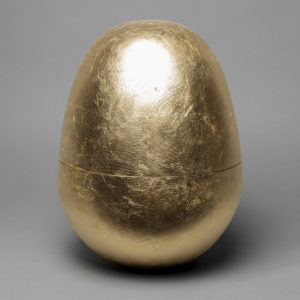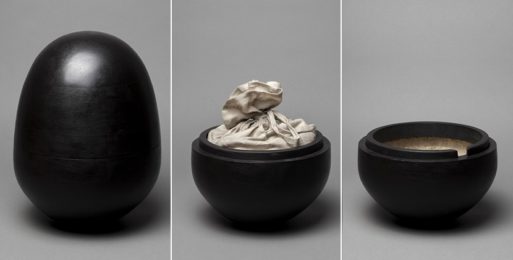
Credit: dezeen.com
Walk into most funeral parlors in the United States, and you’ll see rows of somber, muted urns resting on the display shelves. For centuries, Western culture has thought of funerals and funeral accessories as dignified and utterly sanitized. Any attempts at bringing whimsy to this traditionally heavy service have been met with raised eyebrows, or even outright condemnation. Death isn’t supposed to be “fun.”
But artist Wolfgang Natlacen has had enough. He wants to bring a lighthearted, childlike innocence back to this centuries-old tradition, and he does so with his one-of-a-kind, egg-shaped urns.
The urns are oval-shaped and detach at the center — imagine a nesting doll containing a small cloth satchel filled with ashes. Made of sturdy acacia wood, the urns sit on curved bases and are heavy enough that they won’t tip over when then are touched. Unlike standard urns that rest on a mantel or behind a glass case for decades, Natlacen’s egg-urns roll around on the floor and spin like tops.
He calls his creations “misirizzi,” which means “roly-poly toy” or “tilting doll” in Italian. Although misirizzi are usually designed for children, featuring clowns or other humorous characters, Natlacen designs his urns for adults to use. When adults play with the urns, Natlacen wants them to remember their loved one with joy and happiness while experiencing his whimsical pieces of art.

Credit: catalogodiseno.com
The misirizzi’s enormous size (you’ll need to hold this urn with both hands) and thick wooden structure allows it to tip, roll and topple without putting its precious contents at-risk. The result is perhaps the first-ever urn toy — a way to interact with a loved one’s ashes like never before.
Wolfgang Natlacen was inspired by Egyptian burial methods when he crafted his first misirizzi. Ancient Egyptians used acacia wood to carve sarcophagi for the dead, often painting them gold. The goal was to create a beautiful art piece that would properly memorialize the person who died and last for centuries. Natlacen also paints his misirizzi gold or black, a nod to the ancient Egyptian influence.
Natlacen’s art blurs the lines between life and death. On one hand, you have an urn with real ashes inside, representing the loss of life. On the other, you are enticed to play with the urn as if you were a child, representing life at its most lively and assertive. Rather than separating death from life via somber, grey reflections, the urns encourage us to interact with death — even toy with it. In this sense, Natlacen perfectly captures the flirtatious dance between life and death, twisting and twirling together through eternity.

 Wolfgang Natlacen Brings Fun Whimsy to Funerals with Urns That Double as Toys
Wolfgang Natlacen Brings Fun Whimsy to Funerals with Urns That Double as Toys


 John Mulaney’s “Funeral Planning” on Netflix: No Real Plan
John Mulaney’s “Funeral Planning” on Netflix: No Real Plan

 Composting Bodies Is Now Legal in a Dozen States
Composting Bodies Is Now Legal in a Dozen States














